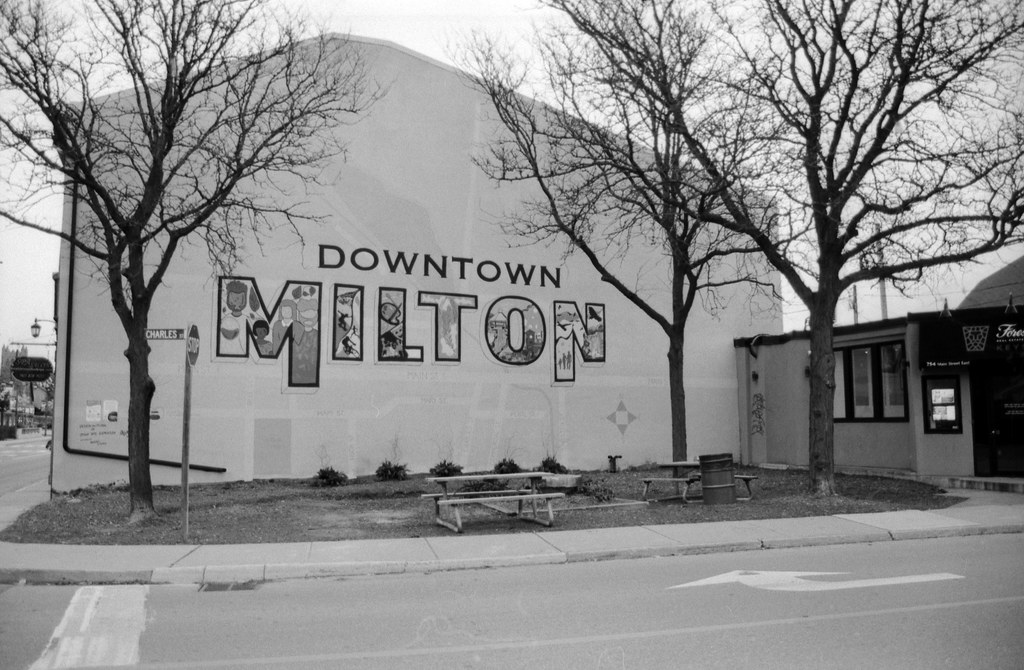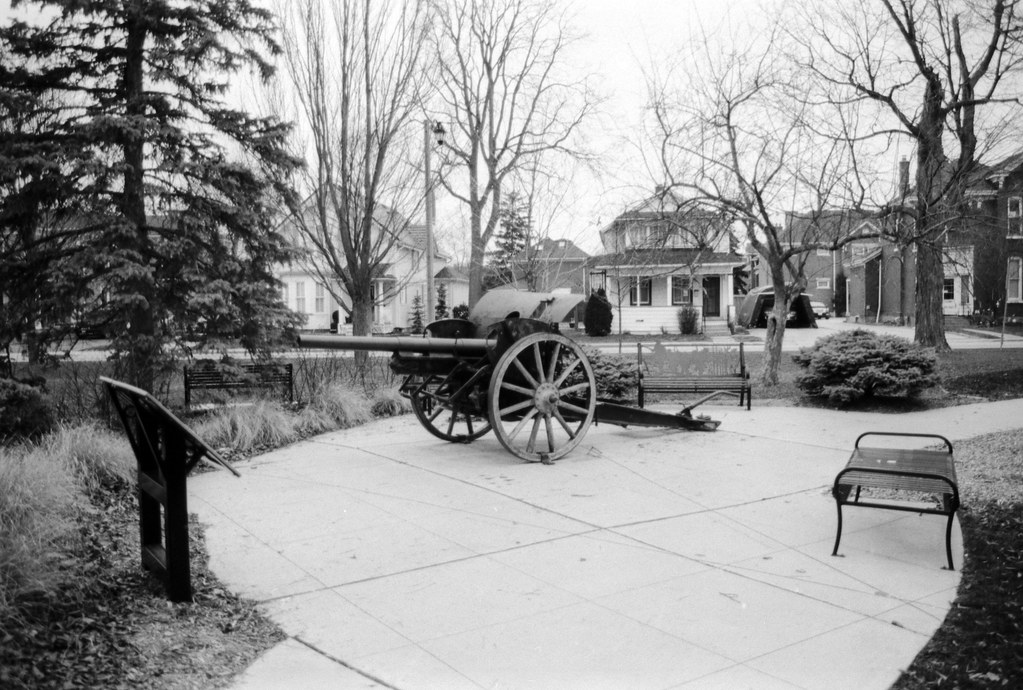If you’ve been following along with my photography for a while, one of my favourite places to visit and take photos is the historic downtown of Milton, Ontario. I’ve called Milton home for forty years and have never tired of photographing the downtown. While I need to drive these days to get here promptly, where I grew up, I could walk here without difficulty. So as an introduction to a group of potential new blog viewers, I look into my hometown for the first month of 2023’s Frugal Film Project.

Minolta Maxxum 70 – Minolta Maxxum AF 28-100mm 1:3.5-5.6 D – Arista EDU.Ultra 100 @ ASA-100 – Adox FX-39 II (1+9) 7:00 @ 20C
The modern town of Milton, Ontario, sits upon the traditional territories of the Neutral, Huron-Wendat, Haudenosaunee, Anishinaabeg and Mississauga peoples. With the earliest known human settlements dating to 1200CE and 1500CE. By the late 18th and early 19th Centuries, much of the territory had been ceded to British Colonial agents under treaties 3, 13, and 14. The area was surveyed and designated as part of the Gore District, Halton County, Trafalgar Township. Jasper Martin, his wife Sarah and two young sons settled on a 100-acre Crown Grant designated Lot 14, Concession 2. Lot 14 had access to the Sixteen Mile Creek, and Martin quickly constructed a home and a water-powered grist mill by 1821. In addition to the Martins, the Harrisons established a farm on Lot 12, Concession 1. The Harrisons are an interesting bit of local history, as in 1824, the death of Thomas Harrison left Elizabeth Harrison to run the family farm and raise the children. Elizabeth was also instrumental in bringing the first church into the community growing up around Martin’s mill. The grist and saw mill drew in more families, and the postal service was established in 1836. The name Milton was given to the settlement in honour of noted poet John Milton, a favourite of the Martin Family. The sale of the Teetzel lot spurred rapid growth through the mid 19th Century, and Milton was incorporated as a town in 1857 and named the seat of Halton County (built the courthouse faster than Oakville, which was the more logical choice). George Brown (not that George Brown) was elected as the first mayor. Further expansion came after World War Two and again in 2002 when the big pipe came in from Lake Ontario. Today Milton is a town of over 100,000 and is still growing!

Minolta Maxxum 70 – Minolta Maxxum AF 28-100mm 1:3.5-5.6 D – Arista EDU.Ultra 100 @ ASA-100 – Adox FX-39 II (1+9) 7:00 @ 20C
Minolta Maxxum 70 – Minolta Maxxum AF 28-100mm 1:3.5-5.6 D – Arista EDU.Ultra 100 @ ASA-100 – Adox FX-39 II (1+9) 7:00 @ 20C
Minolta Maxxum 70 – Minolta Maxxum AF 28-100mm 1:3.5-5.6 D – Arista EDU.Ultra 100 @ ASA-100 – Adox FX-39 II (1+9) 7:00 @ 20C
Minolta Maxxum 70 – Minolta Maxxum AF 28-100mm 1:3.5-5.6 D – Arista EDU.Ultra 100 @ ASA-100 – Adox FX-39 II (1+9) 7:00 @ 20C
Milton is more than the historic downtown. And I could have stretched out the shooting over several days to try and capture each section of the town. But the further out from the historical centre of Milton, the less photogenic it becomes. As Milton went through several growth phases, the less interesting it became. And sure, there are some historic homes spaced out through the newer sections. I wanted to get the most bang for the roll of twenty-four. I ended up selecting images that have a well-documented or exciting history attached to them. I also picked out locations that are special to my wife and me or are connected to my interests. Most of our historic buildings still stand thanks to the Milton Historical Society’s work. Most dates to the 1850s, but a few are from the town’s early days. So there’s a couple of churches, an artillery piece, and both the old and new town halls: two favourite restaurants (Thai and Sushi) and even an active blacksmith shop. The shop itself was a big win for the Milton Historical Society as the Waldies are still active in the community, and the shop itself saw major renovations and restorations.

Minolta Maxxum 70 – Minolta Maxxum AF 28-100mm 1:3.5-5.6 D – Arista EDU.Ultra 100 @ ASA-100 – Adox FX-39 II (1+9) 7:00 @ 20C
Minolta Maxxum 70 – Minolta Maxxum AF 28-100mm 1:3.5-5.6 D – Arista EDU.Ultra 100 @ ASA-100 – Adox FX-39 II (1+9) 7:00 @ 20C
Minolta Maxxum 70 – Minolta Maxxum AF 28-100mm 1:3.5-5.6 D – Arista EDU.Ultra 100 @ ASA-100 – Adox FX-39 II (1+9) 7:00 @ 20C
Minolta Maxxum 70 – Minolta Maxxum AF 28-100mm 1:3.5-5.6 D – Arista EDU.Ultra 100 @ ASA-100 – Adox FX-39 II (1+9) 7:00 @ 20C
I should have under-exposed and then pushed the film when developing. January has been a grey, dull month with lots of rain, but I thought I would get some brighter light in the mid-morning with only a light cloud cover. Sadly I was mistaken. While it was light, working with a lens that at the 28mm mark only opens to f/3.5, I was not getting fast shutter speeds. Most were averaging around 1/30 to 1/45 of a second. This limited me to only the 28mm end of the lens. While that worked well, as I was mainly capturing buildings, sometimes I needed to zoom in to compose the images better. I could have been under-exposed by two stops (ASA-400), and there are times for FX-39II to push the film. I chose FX-39II as it is a great balanced developer that keeps the grain pleasing and maintains sharpness simultaneously. The problem is that I think the listed time is a bit hot; probably, a thirty-second reduction would have helped reduce the density. I also think the meter was trying too hard with the vast difference in the shadows and highlights. I’ve switched my metering mode to centre-weighted for future rolls.

Minolta Maxxum 70 – Minolta Maxxum AF 28-100mm 1:3.5-5.6 D – Arista EDU.Ultra 100 @ ASA-100 – Adox FX-39 II (1+9) 7:00 @ 20C
Minolta Maxxum 70 – Minolta Maxxum AF 28-100mm 1:3.5-5.6 D – Arista EDU.Ultra 100 @ ASA-100 – Adox FX-39 II (1+9) 7:00 @ 20C
Minolta Maxxum 70 – Minolta Maxxum AF 28-100mm 1:3.5-5.6 D – Arista EDU.Ultra 100 @ ASA-100 – Adox FX-39 II (1+9) 7:00 @ 20C
Minolta Maxxum 70 – Minolta Maxxum AF 28-100mm 1:3.5-5.6 D – Arista EDU.Ultra 100 @ ASA-100 – Adox FX-39 II (1+9) 7:00 @ 20C
While Milton is a space I have photographed a lot over the years, I’ve been capturing digital and silver images; I can still look at the downtown space and find images to capture. It’s essential always to have that ability; sure, it can feel repetitive and boring occasionally, but that feeling usually goes away. What’s happening next month? We’re heading to one of the world’s natural wonders and one of Ontario’s biggest tourist traps. That’s right; we’re going to Niagara Falls.